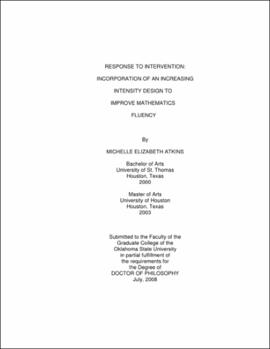| dc.contributor.advisor | Duhon, Gary | |
| dc.contributor.author | Atkins, Michelle Elizabeth | |
| dc.date.accessioned | 2013-11-26T08:34:09Z | |
| dc.date.available | 2013-11-26T08:34:09Z | |
| dc.date.issued | 2008-07 | |
| dc.identifier.uri | https://hdl.handle.net/11244/7298 | |
| dc.description.abstract | Although there is ample evidence regarding the effectiveness of the response to intervention (RTI) model for assessing reading disabilities, the utility of the RTI model in assessing other academic domains has remained relatively unexplored. The purpose of this study was to investigate an RTI model in mathematics wherein an effective general education intervention was implemented with students in the second grade. Participants in this study were 5 teachers and 71 general education students from an elementary school in a Southwest rural community. The first phase of this study involved a class-wide intervention utilizing goal-setting and reinforced practice and was implemented over 24 sessions. Slopes were calculated for each student using least squares regression to determine learning trajectories. These slopes were then used to establish proficiency groups (High Rate Responders, Average Rate Responders, and Low Rate Responders) based on the students' response to intervention. Each response group had remarkably different learning trajectories. Low Rate Responders (n = 4) were included in the second phase of the study. Phase two entailed using the same intervention at increasing intensity levels to improve the response (i.e. slope) of students who responded poorly to the initial intervention phase. The students' response to increasing intervention intensity was evaluated within a multiple baseline design across subjects. Results of this study indicate that the application of an intervention hierarchy design involving increased intervention frequency reduced the difference between the slope of average rate learners and low rate learners. | |
| dc.format | application/pdf | |
| dc.language | en_US | |
| dc.rights | Copyright is held by the author who has granted the Oklahoma State University Library the non-exclusive right to share this material in its institutional repository. Contact Digital Library Services at lib-dls@okstate.edu or 405-744-9161 for the permission policy on the use, reproduction or distribution of this material. | |
| dc.title | Response to intervention: Incorporation of an increasing intensity design to improve mathematics fluency | |
| dc.contributor.committeeMember | Stinnett, Terry | |
| dc.contributor.committeeMember | Mesmer, Eric | |
| dc.contributor.committeeMember | Mesmer, Heidi | |
| osu.filename | Atkins_okstate_0664D_2673.pdf | |
| osu.accesstype | Open Access | |
| dc.type.genre | Dissertation | |
| dc.type.material | Text | |
| dc.subject.keywords | response to intervention | |
| dc.subject.keywords | intervention | |
| dc.subject.keywords | mathematics | |
| dc.subject.keywords | fluency | |
| dc.subject.keywords | learning disabilities | |
| dc.subject.keywords | subtraction | |
| thesis.degree.discipline | School Psychology | |
| thesis.degree.grantor | Oklahoma State University | |
